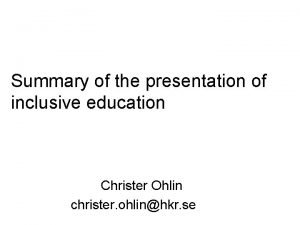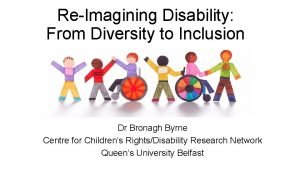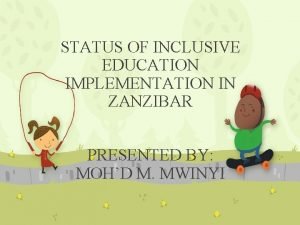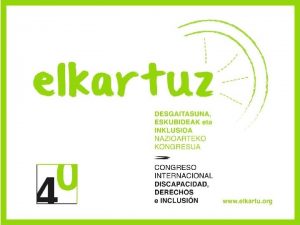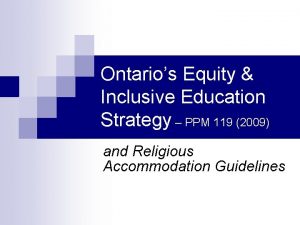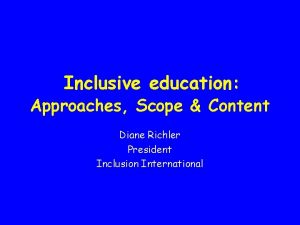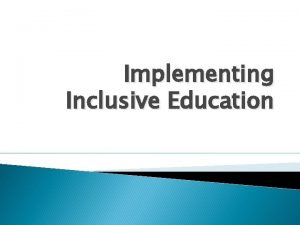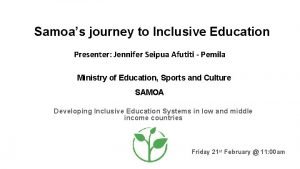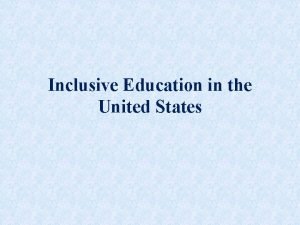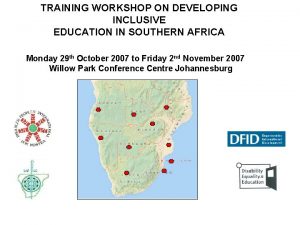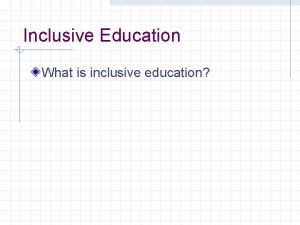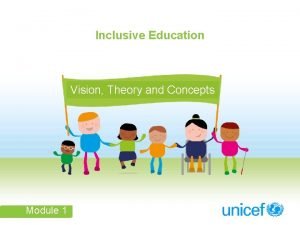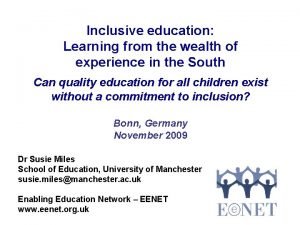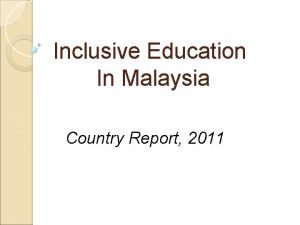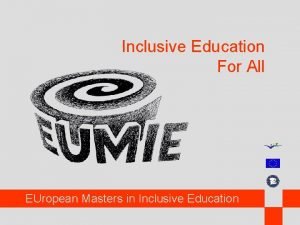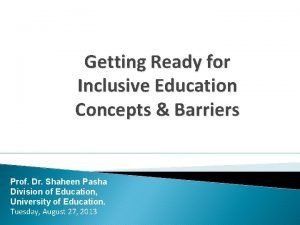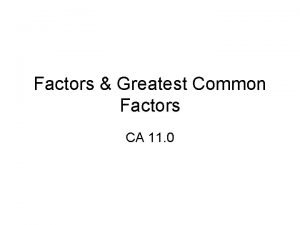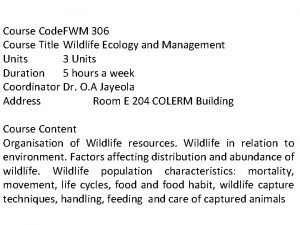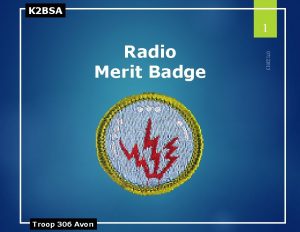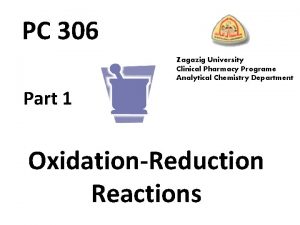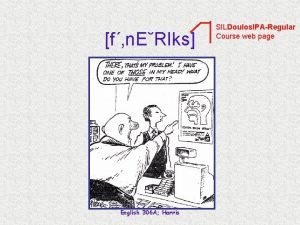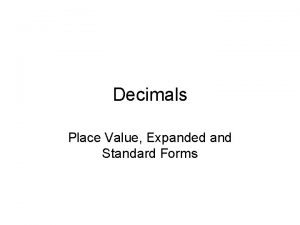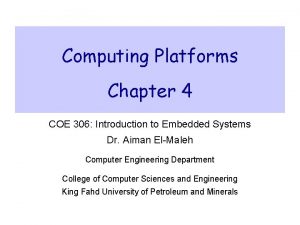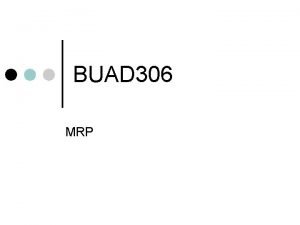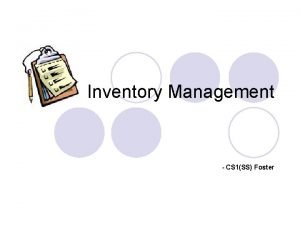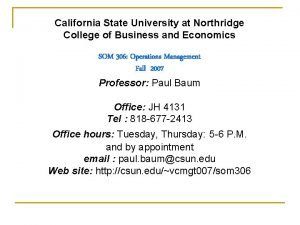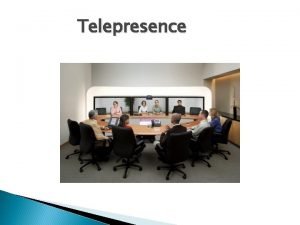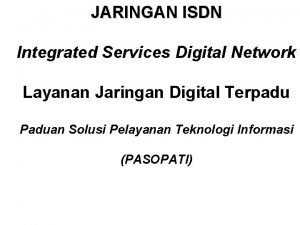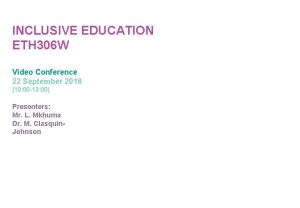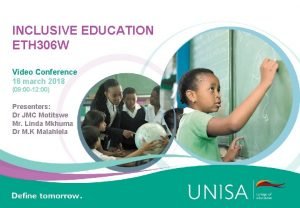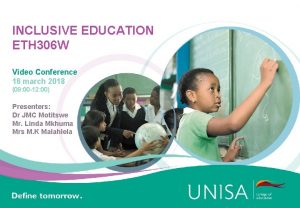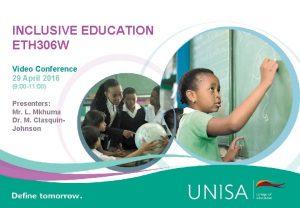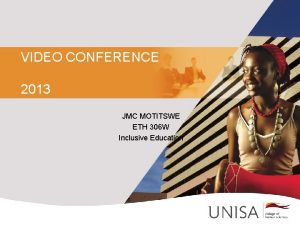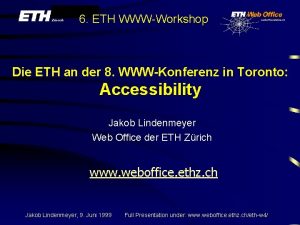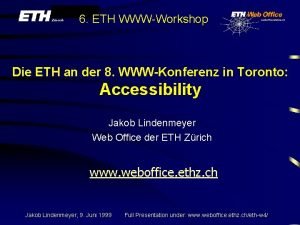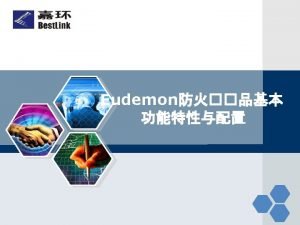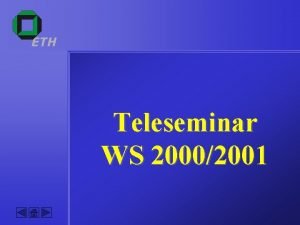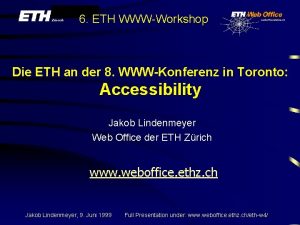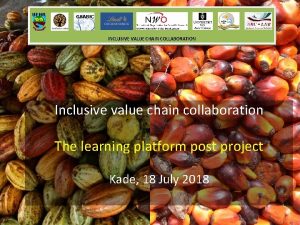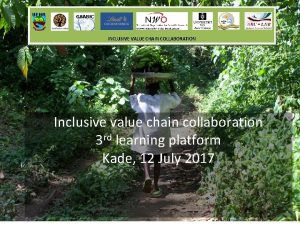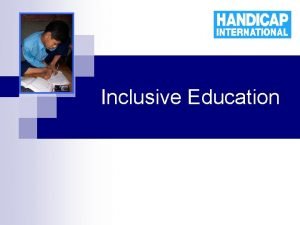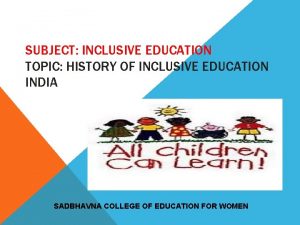INCLUSIVE EDUCATION ETH 306 W Video Conference 14










































- Slides: 42

INCLUSIVE EDUCATION ETH 306 W Video Conference 14 September 2018 (10: 00 -13: 00) Presenters: Dr JMC Motitswe Mr. Linda Mkhuma Mrs K. M. Malahlela

INTRODUCTION TO LECTURERS • Dr Jacomina Motitswe – Primary Lecturer • Mr Lindokuhle Mkhuma – Secondary Lecturer • Dr Kate Malahlela - Third Lecturer NB. Dr Clasquin-Johnson is not a lecturer for ETH 306 W anymore – Please do not bother

COMMUNICATION WITH LECTURES • Write an email/Phone directly. Use your student number as reference and your mylife email address • Direct enquiries related to the module, ETH 306 W. Lecturers may not always assist in matters such as delivery of study material, special examinations, sick notes etc. Check myunisa website for direct contact to these services

SUPPORT • • Discussion forums Special Announcements on myunisa Telephone conversation Office visits with prior arrangement through an email • Email responses

TUTORIAL SUPPORT - NOT • We do not ask for payment for providing support to our students • We do not conduct Saturday Tutorial classes • We do not have Tutors/e-tutors • We do not participate on Whatsup groups – organize whatsup groups

Material for the Module ETH 306 W 1. The official study material for the ETH 306 W: § Tutorial letter 101 § Study Guide § Tutorial Letter 102 § Tutorial Letter 201 –expect this tut letter before examination

Education White Paper 6 (p. 319 -351)

What is inclusion (continued) It is concerned with improving schools√ for staff as well as learners. Acknowledging that all learners have a right to education√ in their local community. Diversity√ is not viewed as a problem to overcome, but as a rich resource√ to support the learning of all. Inclusion is concerned with fostering mutually sustaining relationships between schools and communities√. Inclusion in education is one aspect of inclusion in society√.

Why did South Africa Adopt Inclusive Education? Overview of White Paper 6: Special Needs Education: Building an Inclusive Education and Training System Pillars of IE Ten reasons for inclusion • • • A human right Good educational sense Good social sense The right to learn and live together Accept diversity Respect for one another Uniform and responsive education system Remove discrimination Positive interaction and learning from one another Rehabilitative and supportive society

Inclusion and Mainstreaming Inclusion Mainstreaming Inclusion is about supporting all learners, educators and the system as a whole so that the full range of learning needs can be met. Mainstreaming is about giving some learners extra support so that they can ‘fit in’ or be integrated into the ‘normal’ classroom routine. The focus is on the adaptation of and support systems available in the class- room. Learners are assessed by specialists who diagnose and prescribe technical interventions, such as the placement of learners in programmes.

What is Inclusion? • Increasing participation of all learners, not only those with impairments • Reducing exclusion from cultures, curricula and communities of schools • Responding to learner diversity • Improving schools for teachers and learners • Overcoming barriers to access and participation • Regarding education as a right • Regarding diversity as a rich resource • Fostering mutually sustaining relationships • Acknowledging that all learners need support • Meeting all learners’ needs

Barriers to Learning and Development • Barriers to learning and development provides a shift from ‘learners’ needs’ to barriers – see p. 5 study guide • For example, a learner with Cerebral Palsy is only disabled when the building is inaccessible • Barriers can be within a learner (intrinsic) or in the environment (extrinsic) • In this module focus is on how to identify such barriers and classroom support

Intrinsic Barriers to Learning - - Factors inherent in learners themselves. Learners were born with these or acquired them later on. Factors not related to education or environment. Include physical, physiological or mental impairments. Note: degrees of impairments Have a detrimental effect on learner’s progress at school if learner does not receive appropriate support. Note causes: genetic factors, prenatal/perinatal/postnatal brain damage (epilepsy, cerebral palsy, learning impairments such as dyslexia (difficulty with reading) or dyscalculia (difficulty with arithmetic), intellectual impairment, hearing impairment, visual impairment) These learners require more specialised educational methods and teaching aids.

Extrinsic Barrier to Learning Causes of barriers to learning Environmental factors – poor medical services, lack of cognitive stimulation etc Factors of Upbringing School Factors – overprotection, poor discipline, unnecessary parental pressure Differences in Language and Culture – poor teaching, teachers lack of appropriate qualifications etc Limited Job Prospects -

School Factors • Teachers who do not set good exampes to learners • Uninspiring teaching methods – unstimulating • Lack of sensitivity to the needs of learners • Unmotivated/lazy teachers • Lack of qualifications • Inappropriate study material etc

Samples of barriers and support As a teacher, you have to be aware of the manifestation of difficulties and strategies to support learners in your class. § Hearing, Blindness, § Epilepsy § Down syndrome, Autism § Perceptual-Motor Skills § Language, learning problems, Emotional problems, spoken language, written language, Mathematics, Emotional needs

Perceptual-motor skills Gross motor abilities refer to the poor of coordination in learners’ larger muscles of the body. This may result in clumsiness when walking and in balance. Due this poor coordination, learners may be unable to participate in play activities and movement games. Spatial perception refers to the ability to identify relations between objects using concepts such as far away, close, big etc. When learners have not developed these skills appropriately they may have problems in understanding concepts such as beneath, in front of behind etc which are necessary when one wants to point to a direction or make estimates such as length, distance time etc. Laterality is not a skill which learners can learn but it is a concept. It is about identifying left or right sides starting from the side of the learner’s body. If this skill is not well developed in three year olds it may affect areas such writing from right to left on a page and other areas where sides of the body are used to give direction.

Different parental attitudes. - Grief - Guilt - Anxiety - Resentment - Denial - Anger - Overprotection - Rejection - Compensation - Feeling rejected as parents Read pages 41 -45

Unmet emotional needs: The need for love and affection - relationships (bond) with mother and father - attachment - basis for all other relationships The need for security (including the need for economic security) - feelings of security - stable relationships - know what is expected - self-image - Identify: Who am I?

Practical Classroom Support Strategies Cerebral Palsy • Give the learners tasks and responsibilities-with due regard to physical abilities. • Arrange the furniture in the playroom in such a way that the cerebral palsied learners can move about freely. Also make sure that the washbasin and the toilet. • Store apparatus and positions activities in places where the learners will be able to reach them. • Organise floor and table games which the cerebral palsied learners can manage and which will encourage participation. • It is always advisable to build up learners’ self-esteem. Physically disabled learners feel different from other people. • If the learners have difficulty with their handwriting, you could try to get hold of a typewriter, making more time for typing practice and even arranging for an oral examination for the learner. • If learners write extremely slowly, you may allow them to do tests or exams orally. [2 X 5 =10 marks]

What will you do if a learner has an epileptic seizure in your class? - Be alert! Look out for warning signs. Record all incidents of seizures. Remain calm. Prevent the learner from falling. Push furniture out of the way. DO NOT HOLD THE LEARNER OR TRY TO PREVENT MOVEMENT! Ensure that the airway is clear. Turn the learner onto his/her side to prevent choking on excessive saliva. Loosen tight clothing, especially around neck and waist. Seek medical assistance if seizure is protracted, or if learner chokes, or if learner sustains any injuries.

Written language – Appendix K Elements of written language: a) Essay - cognitive component, linguistic, stylistic b) Spelling c) Handwriting Manifestation, Support in each phase

Mathematics Factors that may lead to Mathematical problems a) Inadequate instructions by the teacher a) Too much drill work a) Forcing learners to employ specific methods, p 310

MATHEMATICS - MANIFESTATIONS • • Cannot sort out objects into categories Struggling to understand numerical values Struggling signs such as =, -, X Struggling to add or subtract It all depends on the phase. Read for other phases

Mathematics - Support Generally: a) Start from concrete to abstract b) Sensitivity and empathy –p 314 Specifically: a) Teach basic facts b) Provide enough opportunities for repetition, drill and practical exercises – p 316

Behavioural Problems as a Barrier - - Antisocial behaviour Taking others’ property Aggression Bossiness Egocentricity Destructiveness Antagonism towards members of the opposite sex Social aggression Negatively influence learner’s development and learning Explain each of the above.

Behaviour modification techniques: - Reinforcement - Ignoring Time-out / Withdrawal (special circumstances, with circumspection and warn the learner beforehand) Self-chosen time-out / withdrawal Prevention Redirection Discussion / conversation (and find a workable solution) Special time (spend time alone with the learner) Revise pages 230 -255

Learners with Down Syndrome – Tutorial letter 102

Down syndrome is the result of an oddity of genes in the twenty -first chromosome. Children with this syndrome usually have a slow rate of learning. Motor skills’ challenges are common. Poor manipulation due to: - Hypotonia (low muscle tone) in arms and hands - Shorter limbs and digits - Reduced stamina Implications of motor skills’ challenges are that: - Handwriting may be oversized or undersized and light/sketchy - Manual skills such as cutting, using concrete materials and equipment may be less accurate and completed more slowly.

Visual Perception: - Difficulty ordering a sequence - Reversal of images - Random visual scanning Implications of visual perception difficulties are: - Difficulty in perceiving and predicting a pattern/sequence - Unable to reliably read a number e. g. 43 becomes 34, 6 for 8 etc - Will miss information when presented in a cluttered or random manner. Cognitive characteristics include: - Learners exhibit a wide range of abilities - Comprehension/interpretation of verbal and written instructions appear to be more advanced than actual ability/level. - Abstract thinking is limited - Learners are unable to transfer knowledge to a new situation - Learners are unable to separate pieces of information and form links

Implications of cognitive characteristics are: - Asynchrony across subject areas i. e. may be more skilled in reading than in mathematics. A learner with Down syndrome varies in her/his abilities and skills compared to her/his peers. Comparisons are difficult - Working pace is usually slow due in part to intellectual disability and poor motor skills. - Appears to understand/confirm he/she understands but fails to comprehend the activity. - The learner will misinterpret words with more than one meaning e. g. light can relate weight or illumination - Unable to interpret and complete tasks Memory - Short term (working) memory is poor. - Long-term recall is poor. - Difficulty recalling and following the sequence e. g. using a calculator.

Implications of limited memory are that learners may: - Be unable to store information long enough to process and respond to it. - Use incorrect responses to previously known skills. - Experience difficulty getting stared as they are unsure of the sequence. Attending skills - Learner’s work is incomplete - Adult intervention is frequently required to keep the learners on the task - Learners will exhibit a range of problem behaviors. They may not follow the whole class verbal instructions. They tend to complete the last section of the activity. - Learners may pick up an element of the instruction and go off on a tangent in their thinking.

Support Strategies (motor skill problems experienced by learners with Down Syndrome): Use alternative tasks for recording e. g. cut and paste, multiple choice, etc. Use large/adapted equipment (ruler with ridge for gripping, blackboard compass) Reduce the amount of activities/ work expected. Provide proformas in a large size with some information already recorded.

“Autism or Autistic Spectrum Disorder (ASD) is a lifelong, complex, pervasive developmental impairment, which appears to have a genetic predisposition and stems from a multi-faceted origin, causing disturbances in brain development and functioning. ” Typical behaviours may include the following: - Little or no eye contact - Abnormalities in the development of cognitive skills; for example, poor learning skills or resistance to normal teaching methods - Unusual responses to sensory inputs, such as covering the ears - Sense of touch, taste, sight, hearing and/or smell may be heightened or diminished - Bizarre eating patterns - High pain threshold

Support to Learners with Autism

Crying or laughing for no apparent reason - Self-injurious behavior such as head banging, scratching and biting - Abnormal sleep patterns - The development of speech and language may be abnormal, delayed or absent. - A person shows minimal reaction to verbal input and sometimes acts as though deaf. - The repetition of words, questions, phrases and/or sentences over and over again - Endless monologues about their special interests without adapting to the needs of the listener - Words and phrases may be used incorrectly. - The production of speech may be unusual. A flat monotonous tone or inappropriate variations in tone are often noted. -

- Those who are verbal, may be fascinated with words and word games, but do not use their vocabulary as a tool for social integration and reciprocal communication. They have difficulty in initiating or taking part in conversations. Imaginative play may be limited or poor; for example, they cannot play with a wooden block as if it is a toy car. A tendency to focus on minor or trivial aspects of things in the environment instead of an imaginative understanding of the meaning of the whole scene They may display a limited range of imaginative activities, which a teacher may well find have actually been copied off the television or elsewhere. They pursue activities repetitively and cannot be influenced by suggestions of change. Their play may appear complex, but close observation shows its rigidity and stereotyped pattern.

- - Unusual habits such as rocking, spinning, finger-flicking, continual fiddling with objects, spinning objects, tapping and scratching on objects, or arranging objects in lines or patterns Inappropriate use of toys in play Holding onto objects; for instance, carrying a piece of wool the whole day Noticeable physical over-activity or extreme under-activity Tantrums may occur for no reason. Changes in routine of environment; for example, a change in the route to the school or altering the placement of equipment in the classroom may cause distress.

ASSIGNMENTS AND EXAMINATION • Submission of Assignment 1 gives you admission to examination • Year Mark is added ONLY when you have 40% or more • Feedback for assignment TWO will be sent before exam • Pass mark = 50% • Supplementary/Special Exams are written in the next semester

Demarcation or “scoping” for examinations and assessments NB: In terms of a decision reached by the College, lecturers may not demarcate or “scope” specific work for examination purposes. Examination question s should be based on all the work covering the notional hours of modules. Lecturers should encourage students to learn everything. In cases where competencies or skills are assessed differently during the tuition period, the various methods of assessment w ill be spelled out clearly by the lecturer in Tutorial Letter 201. According to Assessment Procedure Manual 2013, paragraph 4. 5. 2(e), the examination memoranda (guidelines, rubrics, and so on) shall not be made available to students. Afbakening vir eksamens en assessering NB: Ingevolge ’n besluit van die Kollege mag dosente nie spesifieke werk vir eksamendoeleindes afbaken nie en moet eksamenvrae gebaseer wees op al die werk wat die nosionele leerure van modules opmaak. Dosente moet studente aanmoedig om alles te leer. In gevalle waar bevoegdhede of vaardighede gedurende die onderrigtydperk by wyse van ander metodes geassesseer word, sal die dosent die verskillende metodes van assessering duidelik in Studiebrief 201 uiteensit. Die 2013 Handleiding vir die Assesseringsprosedure, paragraaf 4. 5. 2(e), bepaal dat die eksamenmemorandums (riglyne, rubrieke, en so meer) nie aan studente beskikbaar gestel sal word nie.

How to contact us: 1. Dr JMC Motitswe Tel: 012 484 1121 Email: Address: 2. Mr. Lindokuhle Mkhuma Tel: 012484 1034 E-mail: mkhumi@unisa. ac. za Address: UNISA Sunnyside Campus, Building no. 10, Office 00 -091, Pretoria 0003 3. Mrs K. M. Malahlela Tel: 012481… E-mail: clasqmg@unisa. ac. za Address: UNISA Sunnyside Campus, Building no. 10, Office 1 -61, Pretoria 0003

 Conclusion inclusive education
Conclusion inclusive education Reimigining disability and inclusive education
Reimigining disability and inclusive education Achievement of inclusive education in zanzibar
Achievement of inclusive education in zanzibar Reimigining disability and inclusive education
Reimigining disability and inclusive education Ontario's equity and inclusive education strategy
Ontario's equity and inclusive education strategy Scope of inclusive education
Scope of inclusive education Unesco inclusive education
Unesco inclusive education Inclusive education policy
Inclusive education policy What is this photo
What is this photo Inclusive education and community partnership
Inclusive education and community partnership Objectives of inclusive education
Objectives of inclusive education Conclusion of rmsa
Conclusion of rmsa Aims and objectives of inclusive education
Aims and objectives of inclusive education Objectives of inclusive education
Objectives of inclusive education Inclusive education definition
Inclusive education definition Disadvantages of inclusive education slideshare
Disadvantages of inclusive education slideshare Jämförlighet
Jämförlighet Acrostic poem
Acrostic poem Definition of inclusive education by authors slideshare
Definition of inclusive education by authors slideshare National general benefits solutions providers
National general benefits solutions providers Factors of 75
Factors of 75 Ecologist
Ecologist Om306
Om306 Troop 306 avon
Troop 306 avon Nh ed 306
Nh ed 306 Virtudes teologales
Virtudes teologales Pc 306
Pc 306 Paulo cesar sentelhas
Paulo cesar sentelhas Meteorologia
Meteorologia Meteorologia cesar
Meteorologia cesar 306
306 306 in expanded form
306 in expanded form 306
306 Product structure tree example
Product structure tree example Buad 306
Buad 306 306 bones
306 bones Navsup form 1282
Navsup form 1282 Som 306 csun
Som 306 csun Disadvantages of telepresence
Disadvantages of telepresence Polycom video conferencing equipment
Polycom video conferencing equipment Adobe video conference
Adobe video conference Gvc conference
Gvc conference Kepanjangan isdn jaringan
Kepanjangan isdn jaringan
